EQUIVALENCE and TRANSLATION METHODS Lecture 3 Lecture Outline

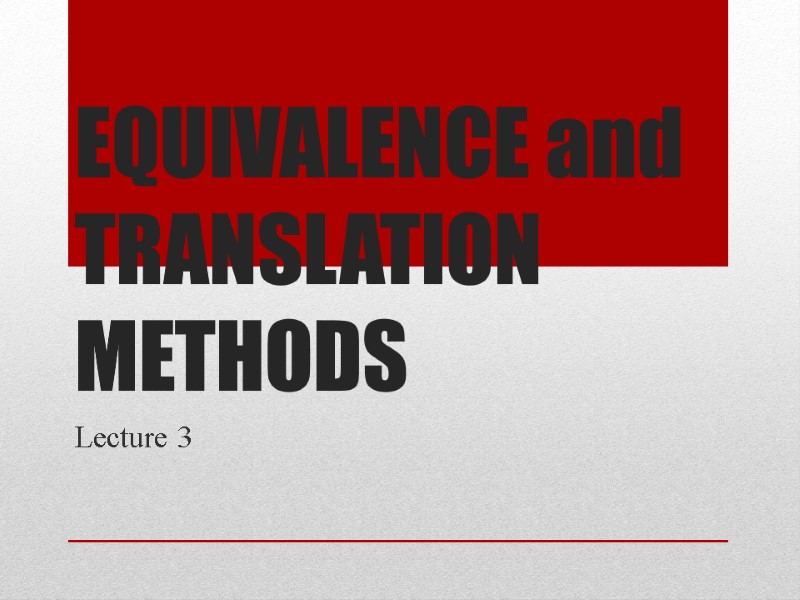
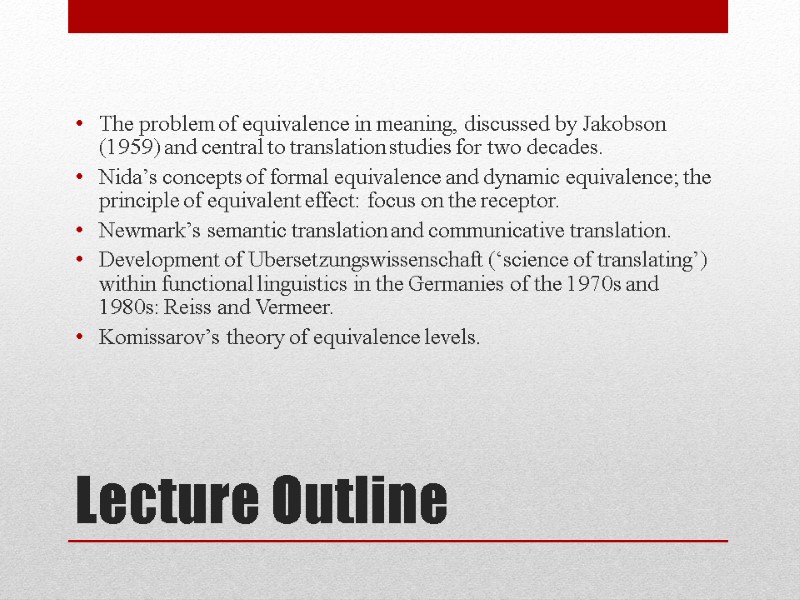

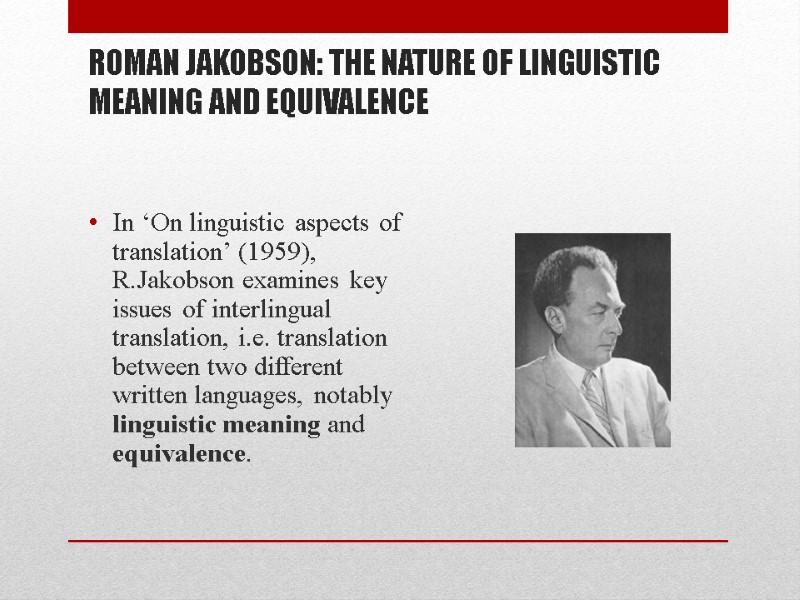
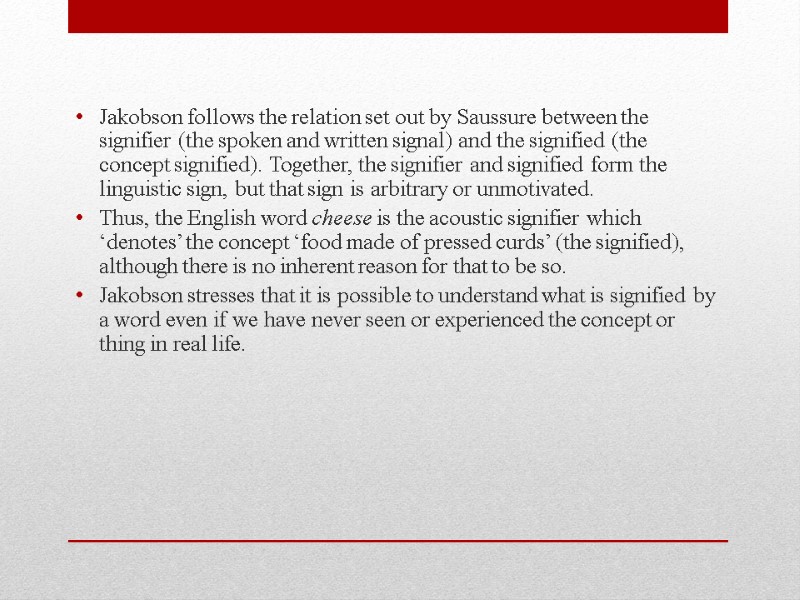
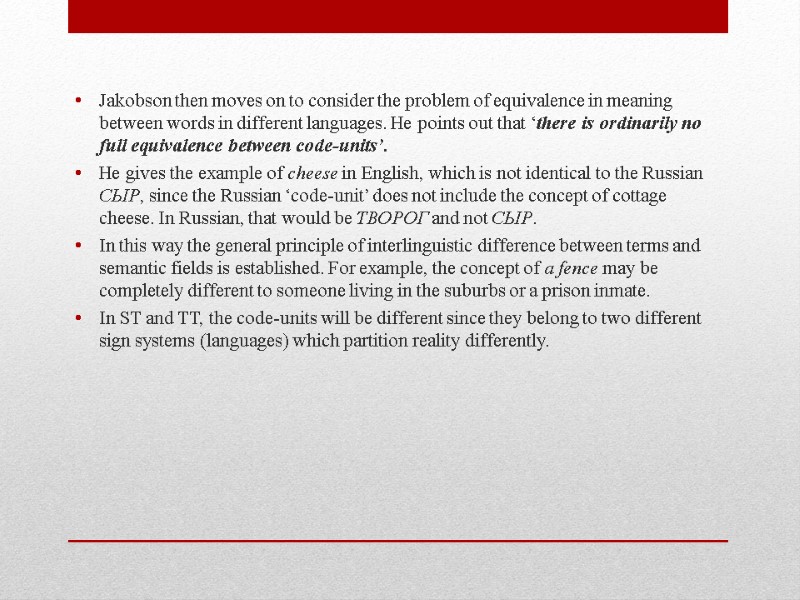
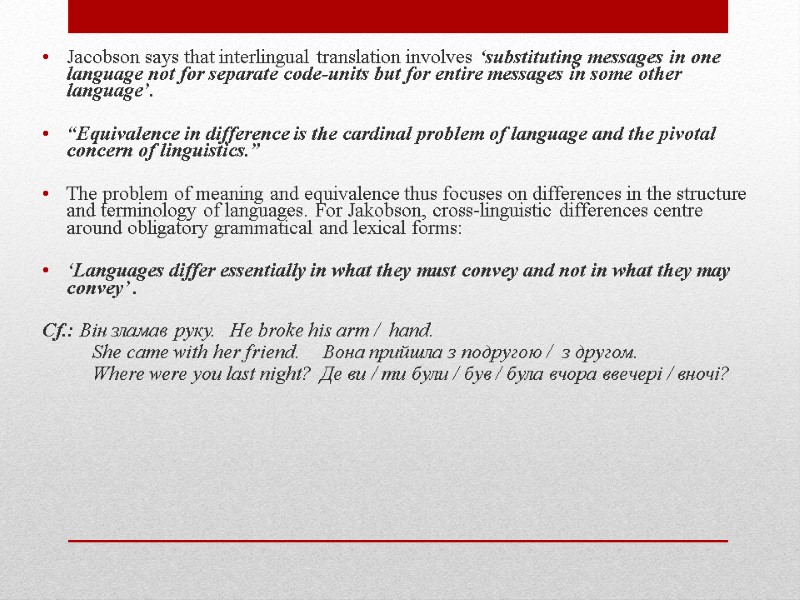
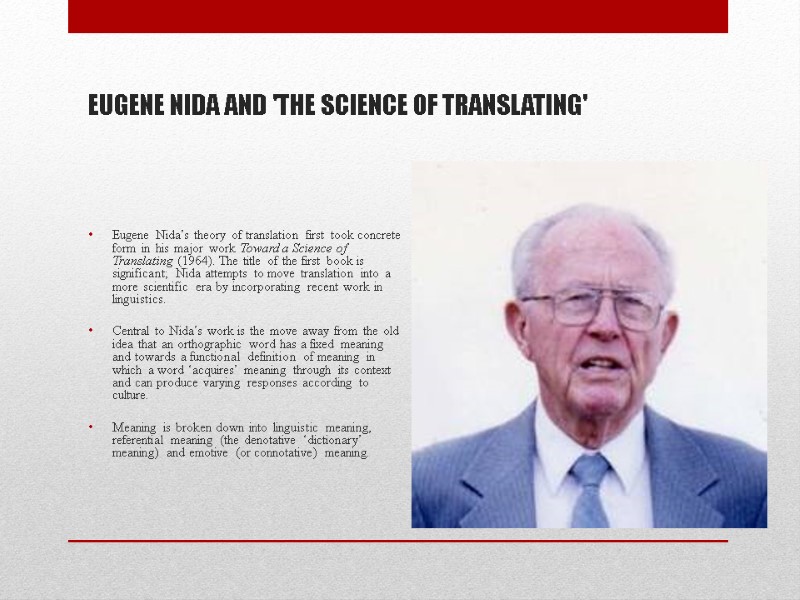
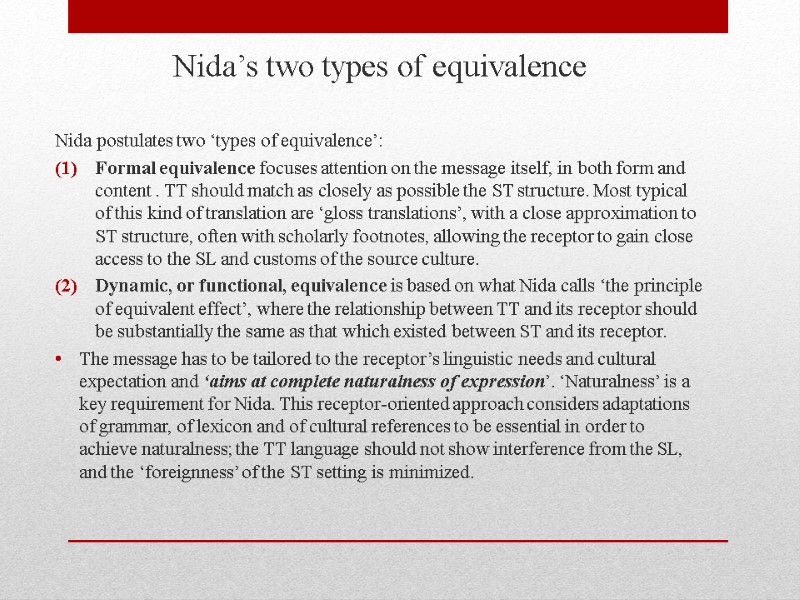
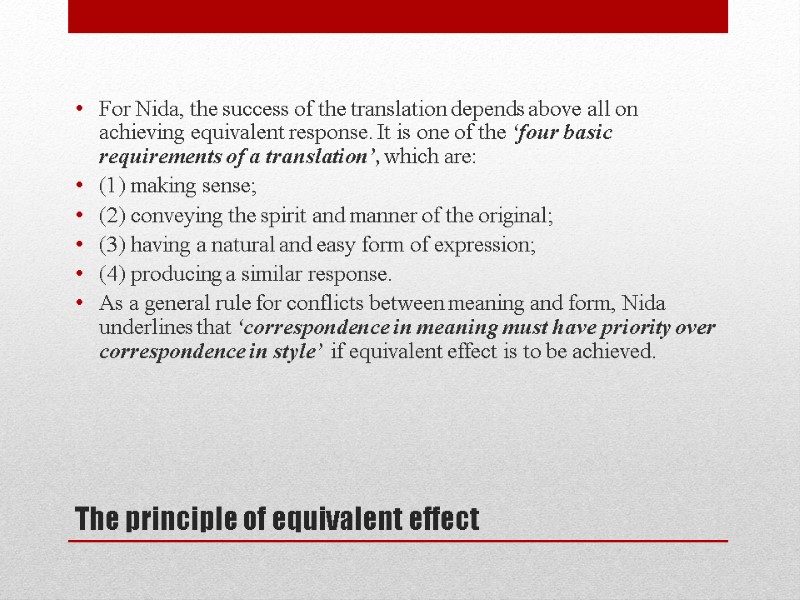
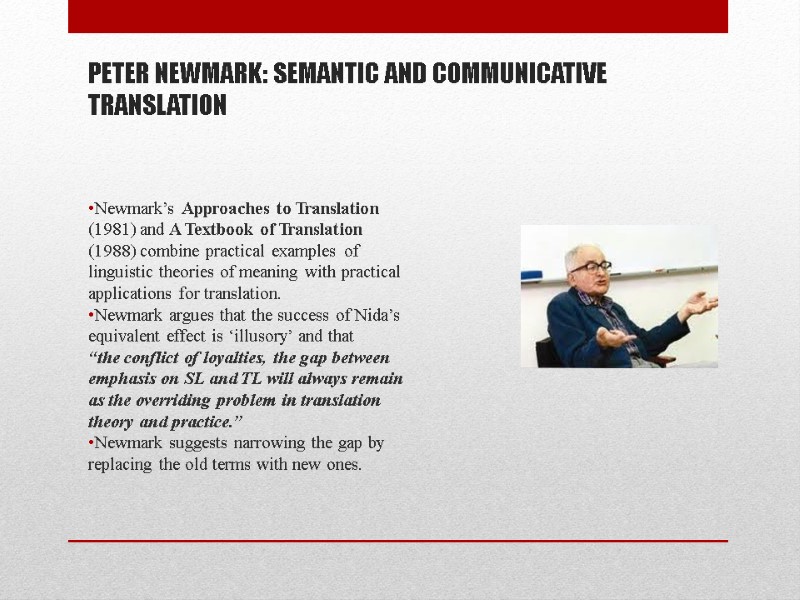
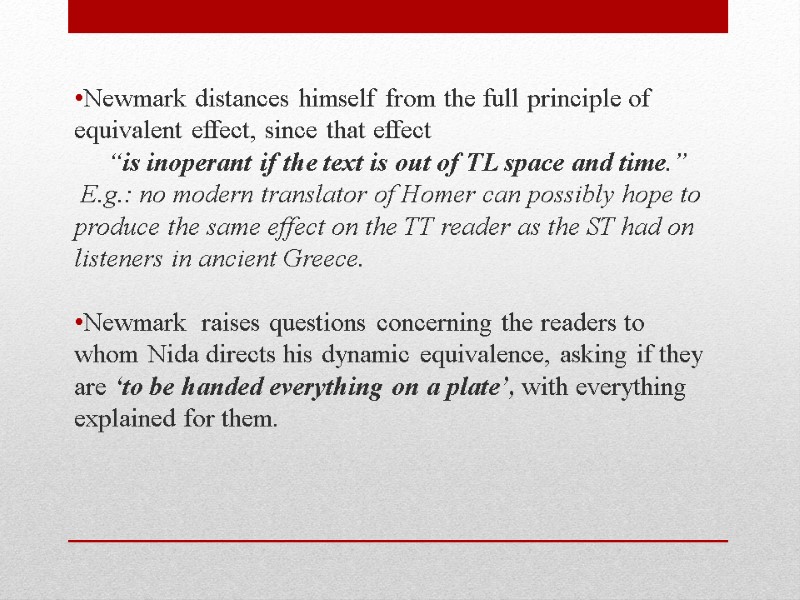
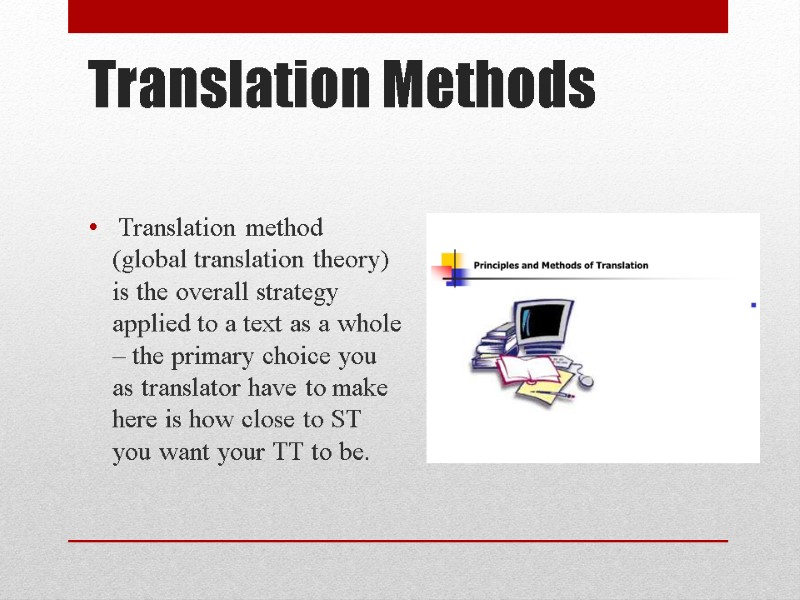
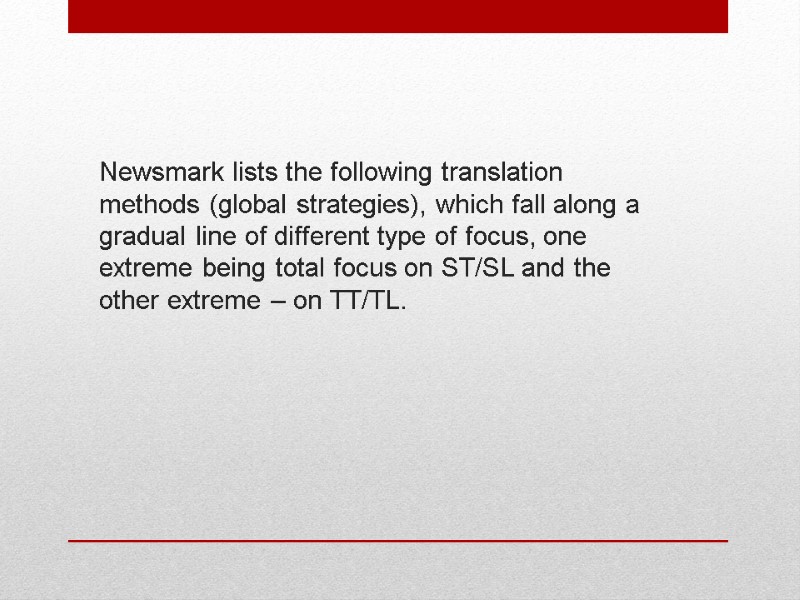
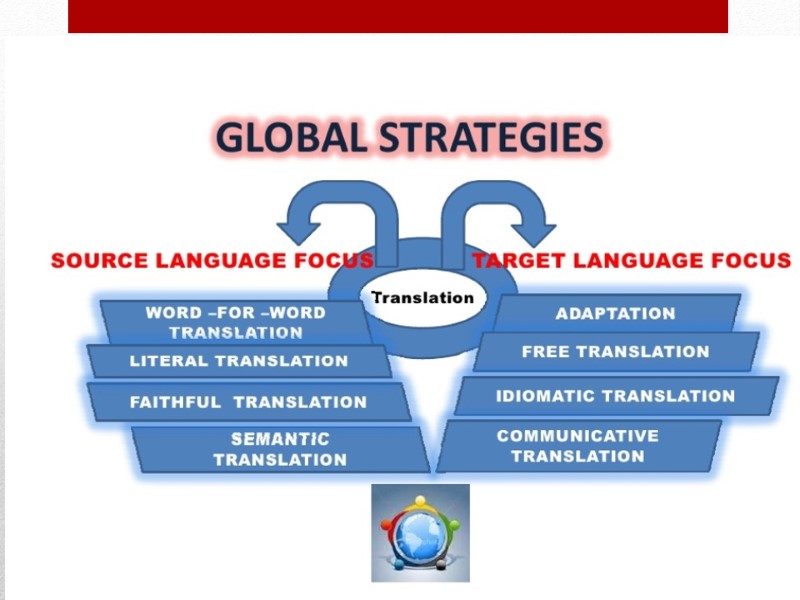
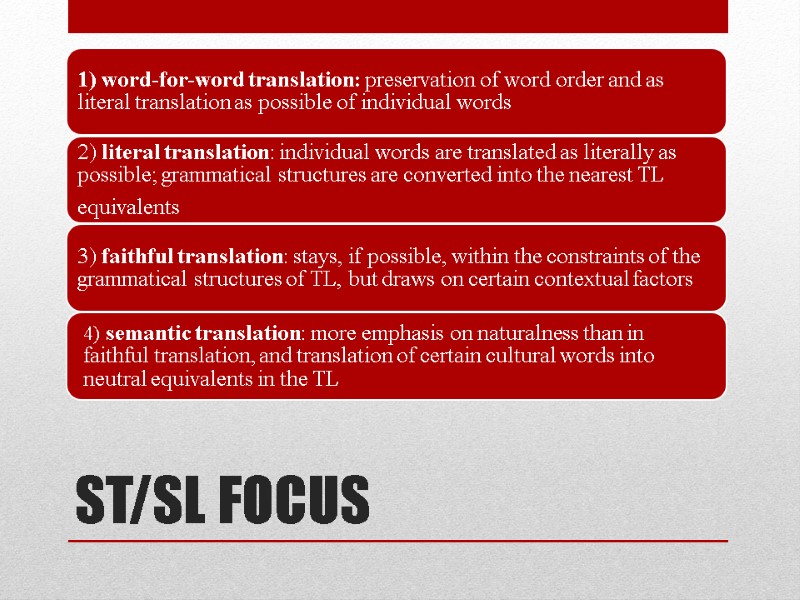
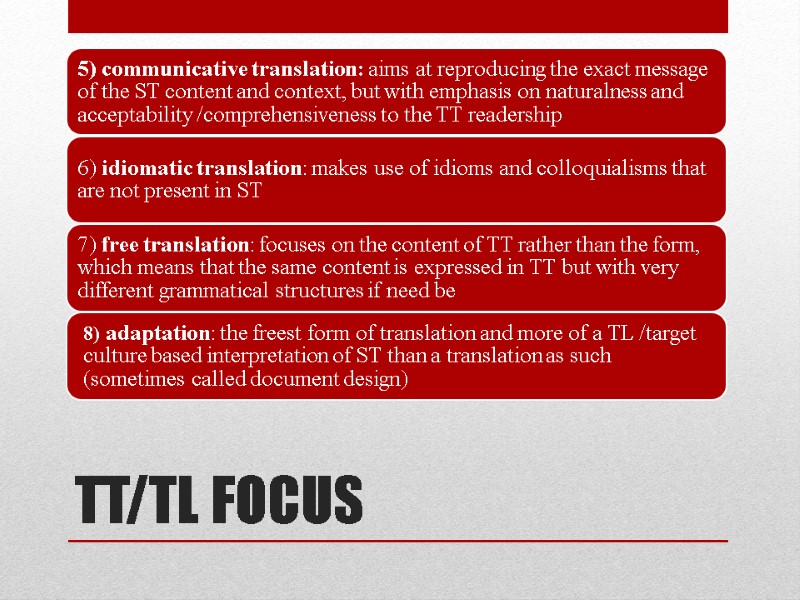
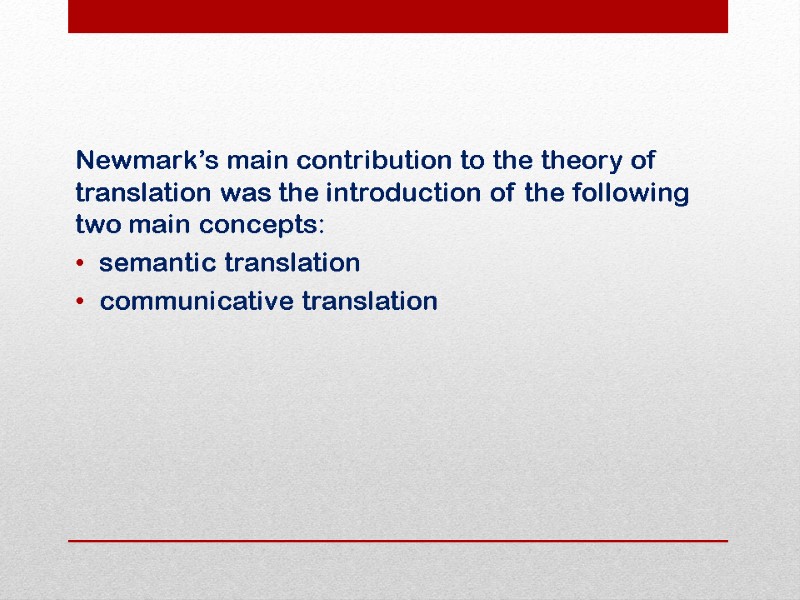
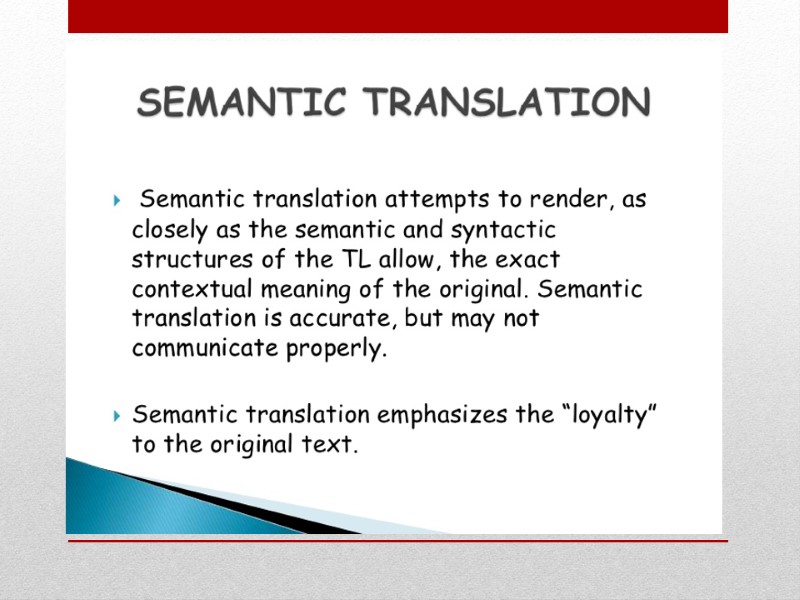
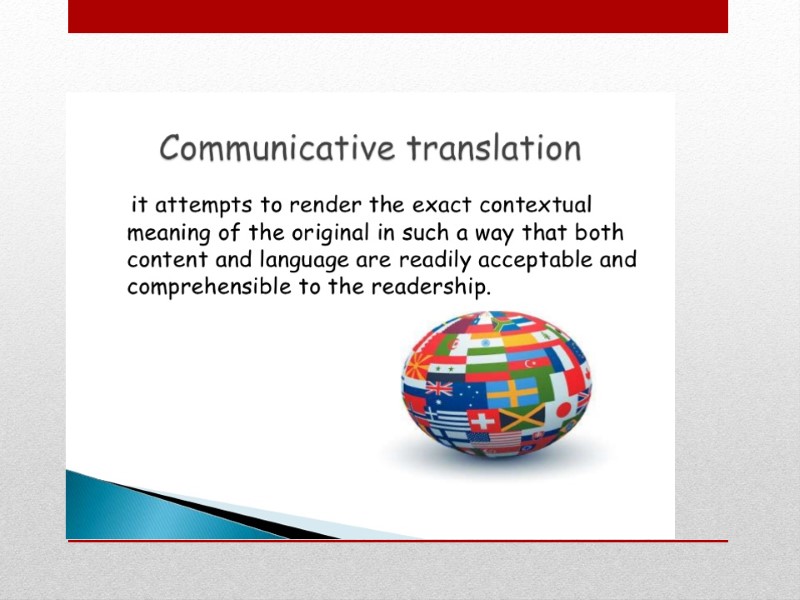
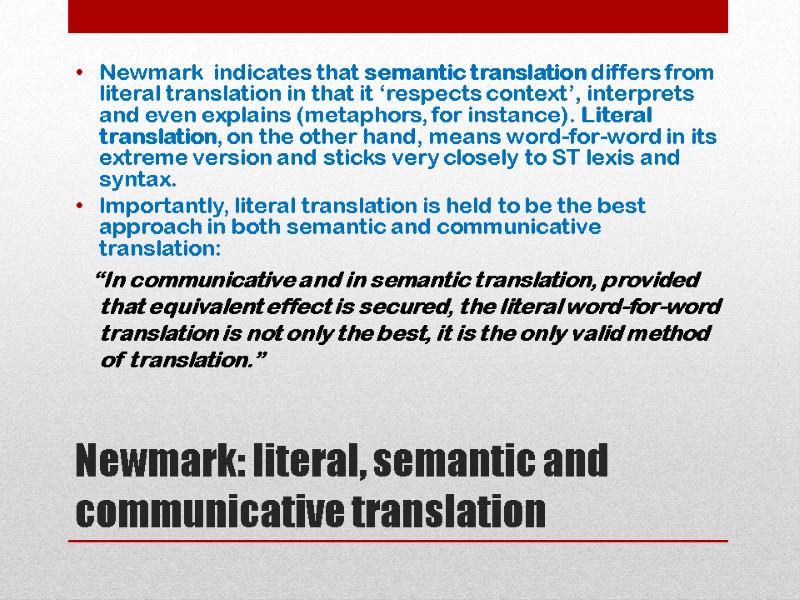
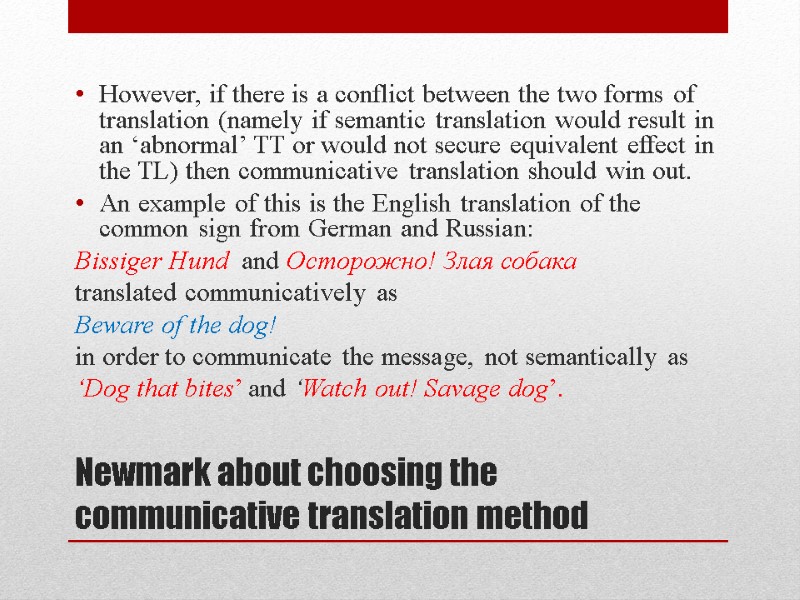
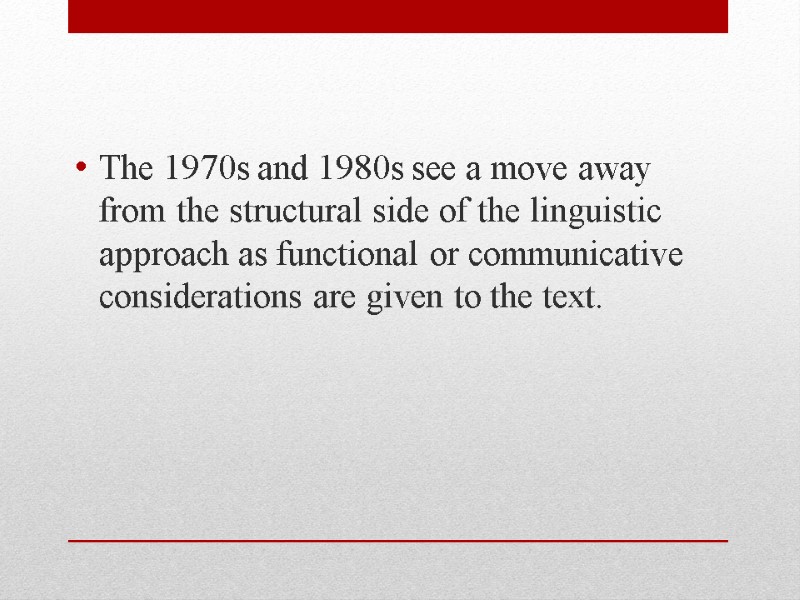
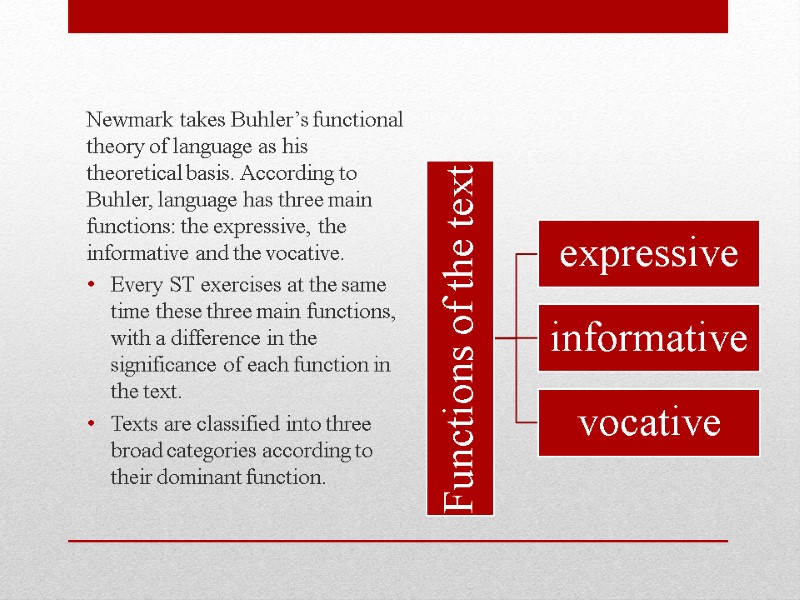
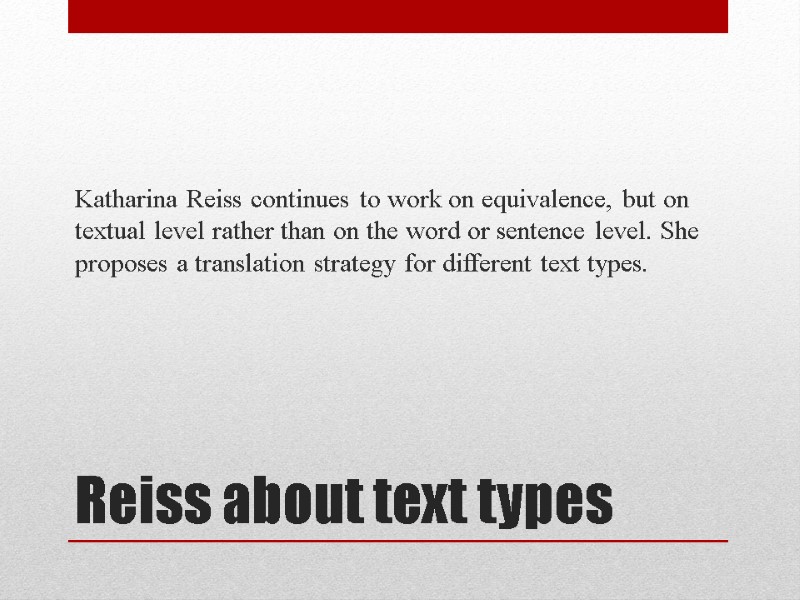
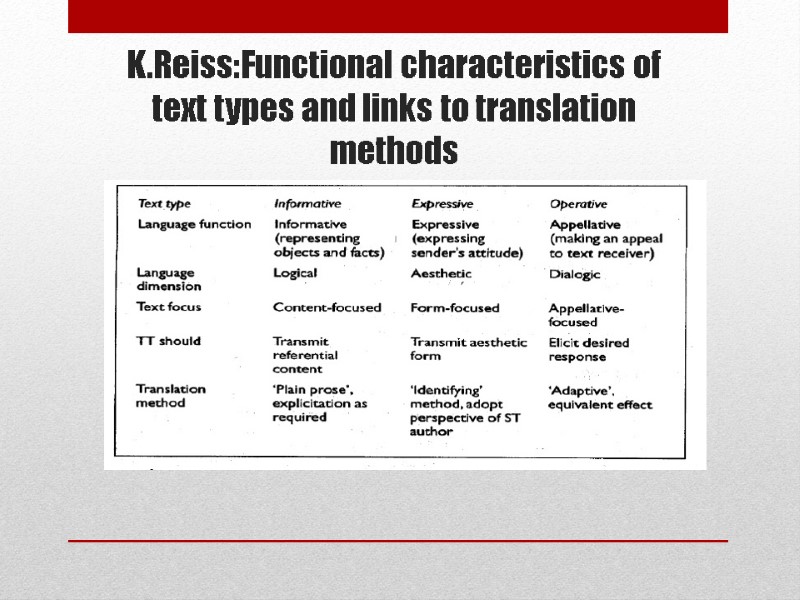
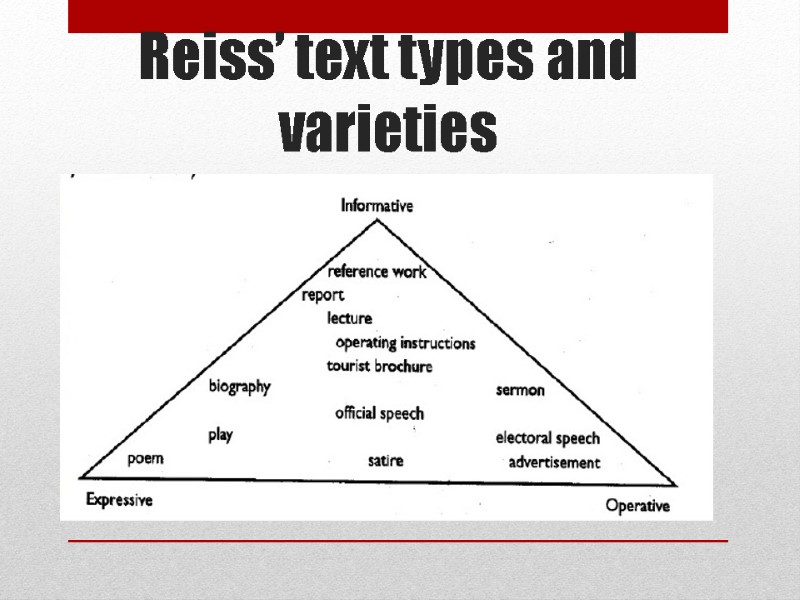
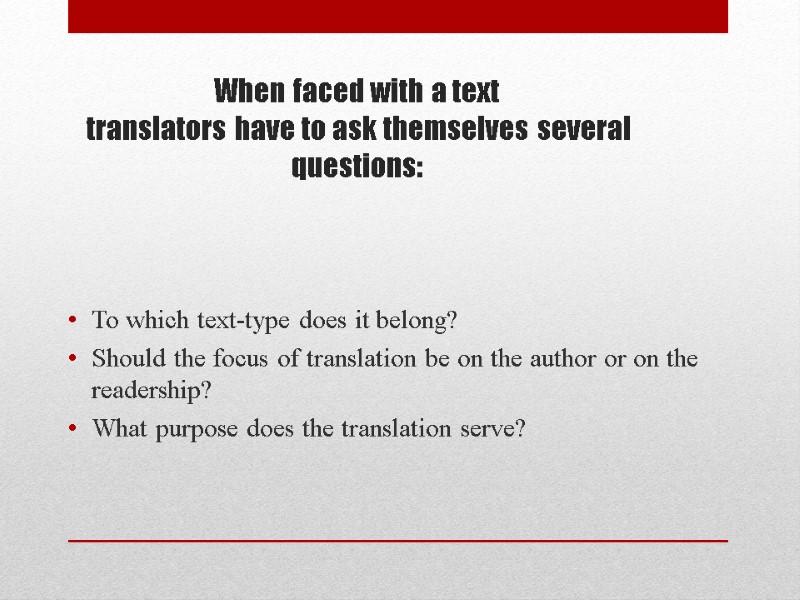

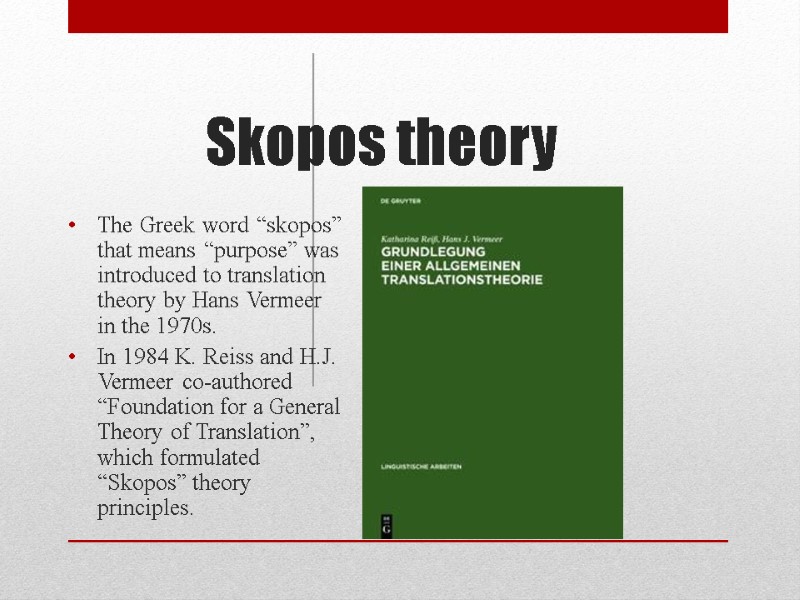
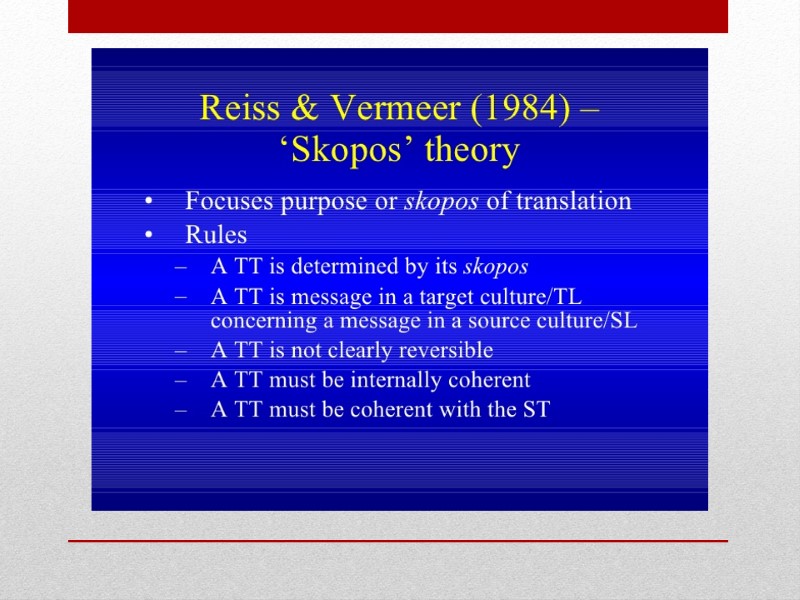
![Skopos rule The dominant factor of each translation is its purpose [Zweck]. Each Skopos rule The dominant factor of each translation is its purpose [Zweck]. Each](https://present5.com/presentacii-2/20171208\14762-equivalence_and_translation_methods.ppt\14762-equivalence_and_translation_methods_32.jpg)
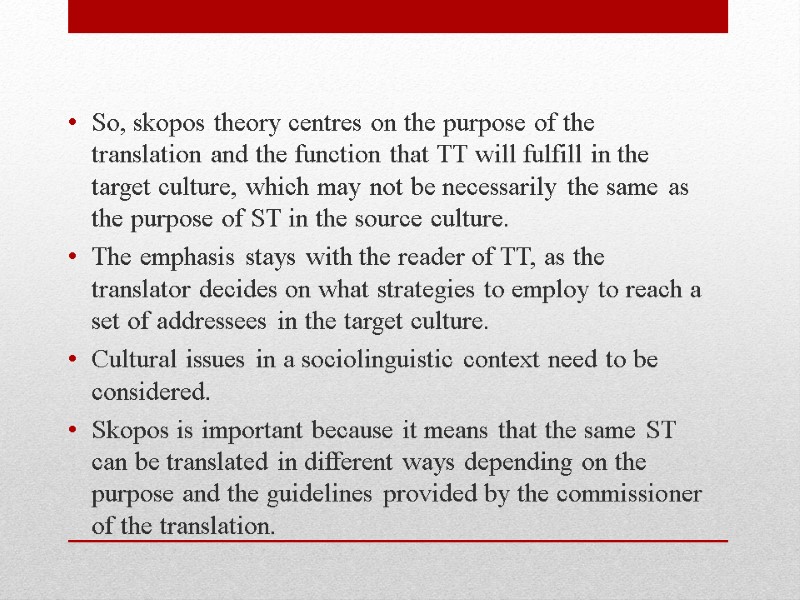

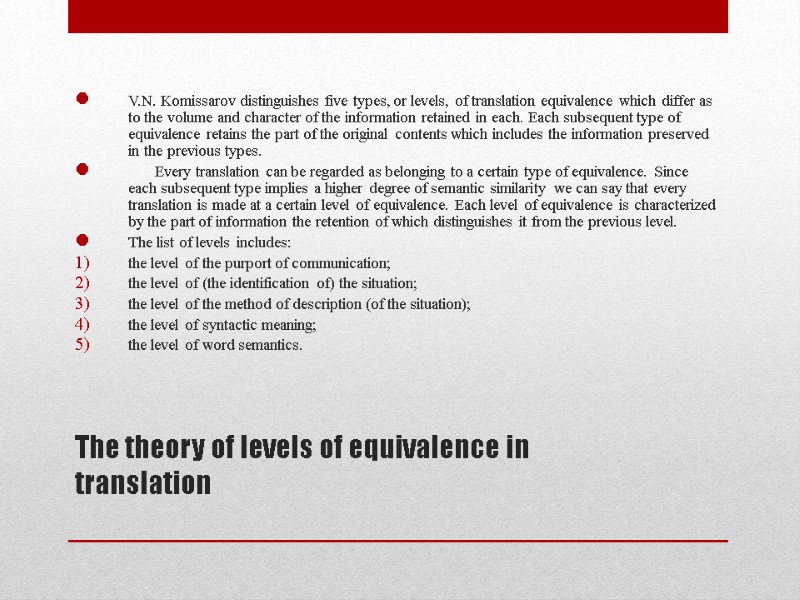

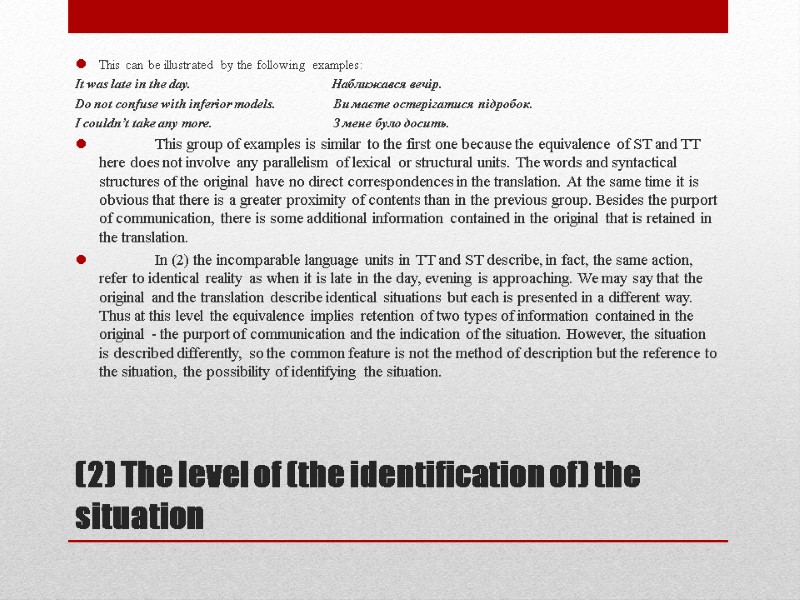
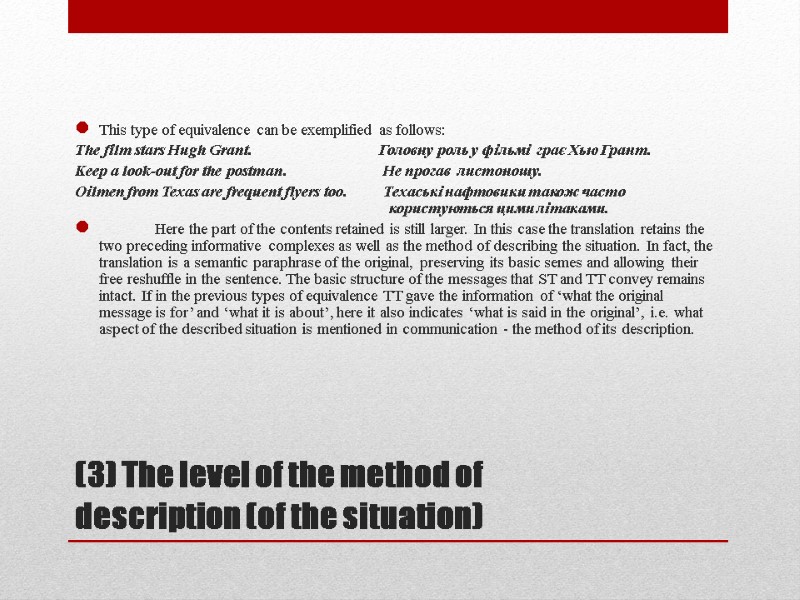
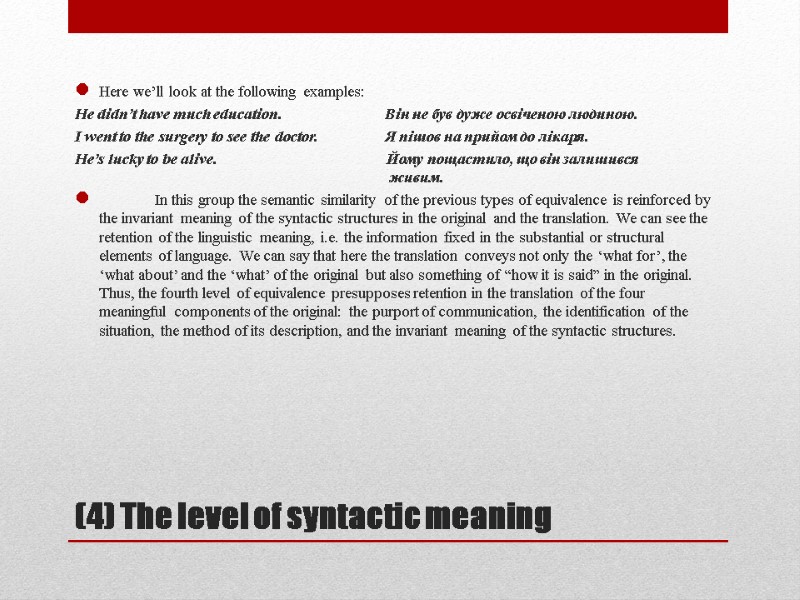
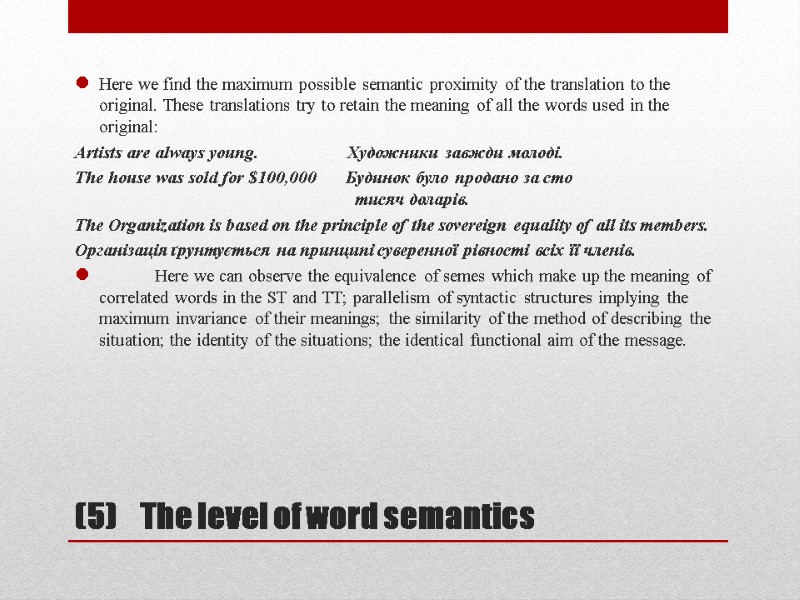
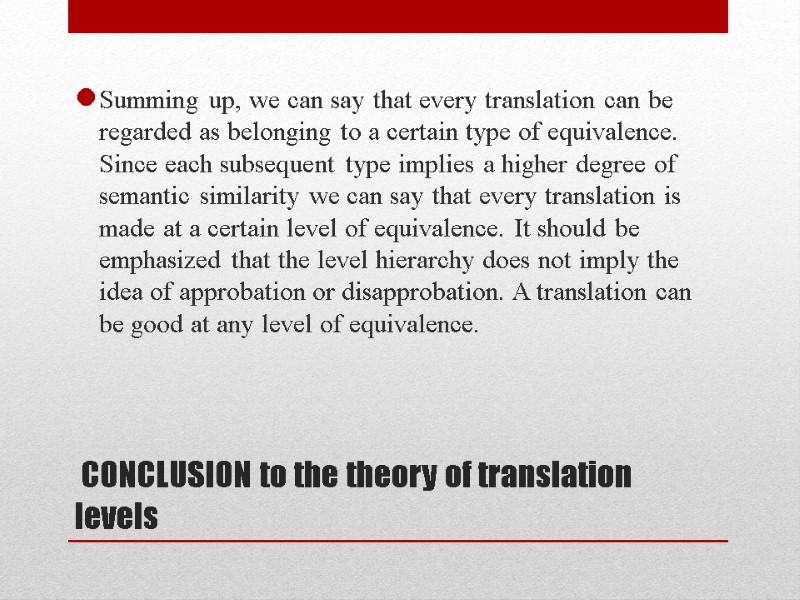
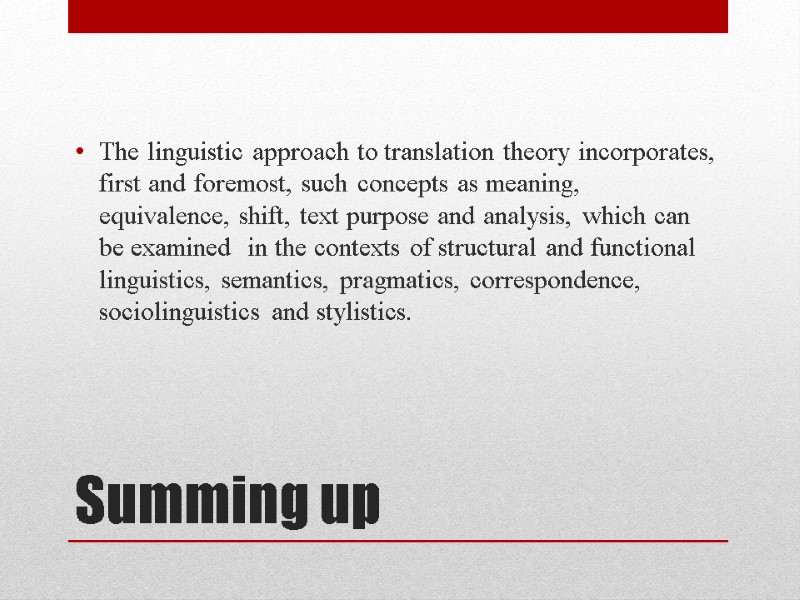
14762-equivalence_and_translation_methods.ppt
- Количество слайдов: 42
 EQUIVALENCE and TRANSLATION METHODS Lecture 3
EQUIVALENCE and TRANSLATION METHODS Lecture 3
 Lecture Outline The problem of equivalence in meaning, discussed by Jakobson (1959) and central to translation studies for two decades. Nida’s concepts of formal equivalence and dynamic equivalence; the principle of equivalent effect: focus on the receptor. Newmark’s semantic translation and communicative translation. Development of Ubersetzungswissenschaft (‘science of translating’) within functional linguistics in the Germanies of the 1970s and 1980s: Reiss and Vermeer. Komissarov’s theory of equivalence levels.
Lecture Outline The problem of equivalence in meaning, discussed by Jakobson (1959) and central to translation studies for two decades. Nida’s concepts of formal equivalence and dynamic equivalence; the principle of equivalent effect: focus on the receptor. Newmark’s semantic translation and communicative translation. Development of Ubersetzungswissenschaft (‘science of translating’) within functional linguistics in the Germanies of the 1970s and 1980s: Reiss and Vermeer. Komissarov’s theory of equivalence levels.
 In spite of differences you can see in various definitions of translation, there is a common feature shared by the absolute majority of them: the notion of equivalence between the original and the translation. The linguistic approach to translation theory focusing on the key issues of meaning, equivalence and shift began to appear in 1950s.
In spite of differences you can see in various definitions of translation, there is a common feature shared by the absolute majority of them: the notion of equivalence between the original and the translation. The linguistic approach to translation theory focusing on the key issues of meaning, equivalence and shift began to appear in 1950s.
 ROMAN JAKOBSON: THE NATURE OF LINGUISTIC MEANING AND EQUIVALENCE In ‘On linguistic aspects of translation’ (1959), R.Jakobson examines key issues of interlingual translation, i.e. translation between two different written languages, notably linguistic meaning and equivalence.
ROMAN JAKOBSON: THE NATURE OF LINGUISTIC MEANING AND EQUIVALENCE In ‘On linguistic aspects of translation’ (1959), R.Jakobson examines key issues of interlingual translation, i.e. translation between two different written languages, notably linguistic meaning and equivalence.
 Jakobson follows the relation set out by Saussure between the signifier (the spoken and written signal) and the signified (the concept signified). Together, the signifier and signified form the linguistic sign, but that sign is arbitrary or unmotivated. Thus, the English word cheese is the acoustic signifier which ‘denotes’ the concept ‘food made of pressed curds’ (the signified), although there is no inherent reason for that to be so. Jakobson stresses that it is possible to understand what is signified by a word even if we have never seen or experienced the concept or thing in real life.
Jakobson follows the relation set out by Saussure between the signifier (the spoken and written signal) and the signified (the concept signified). Together, the signifier and signified form the linguistic sign, but that sign is arbitrary or unmotivated. Thus, the English word cheese is the acoustic signifier which ‘denotes’ the concept ‘food made of pressed curds’ (the signified), although there is no inherent reason for that to be so. Jakobson stresses that it is possible to understand what is signified by a word even if we have never seen or experienced the concept or thing in real life.
 Jakobson then moves on to consider the problem of equivalence in meaning between words in different languages. He points out that ‘there is ordinarily no full equivalence between code-units’. He gives the example of cheese in English, which is not identical to the Russian СЫР, since the Russian ‘code-unit’ does not include the concept of cottage cheese. In Russian, that would be ТВОРОГ and not СЫР. In this way the general principle of interlinguistic difference between terms and semantic fields is established. For example, the concept of a fence may be completely different to someone living in the suburbs or a prison inmate. In ST and TT, the code-units will be different since they belong to two different sign systems (languages) which partition reality differently.
Jakobson then moves on to consider the problem of equivalence in meaning between words in different languages. He points out that ‘there is ordinarily no full equivalence between code-units’. He gives the example of cheese in English, which is not identical to the Russian СЫР, since the Russian ‘code-unit’ does not include the concept of cottage cheese. In Russian, that would be ТВОРОГ and not СЫР. In this way the general principle of interlinguistic difference between terms and semantic fields is established. For example, the concept of a fence may be completely different to someone living in the suburbs or a prison inmate. In ST and TT, the code-units will be different since they belong to two different sign systems (languages) which partition reality differently.
 Jacobson says that interlingual translation involves ‘substituting messages in one language not for separate code-units but for entire messages in some other language’. “Equivalence in difference is the cardinal problem of language and the pivotal concern of linguistics.” The problem of meaning and equivalence thus focuses on differences in the structure and terminology of languages. For Jakobson, cross-linguistic differences centre around obligatory grammatical and lexical forms: ‘Languages differ essentially in what they must convey and not in what they may convey’ . Cf.: Він зламав руку. He broke his arm / hand. She came with her friend. Вона прийшла з подругою / з другом. Where were you last night? Де ви / ти були / був / була вчора ввечері / вночі?
Jacobson says that interlingual translation involves ‘substituting messages in one language not for separate code-units but for entire messages in some other language’. “Equivalence in difference is the cardinal problem of language and the pivotal concern of linguistics.” The problem of meaning and equivalence thus focuses on differences in the structure and terminology of languages. For Jakobson, cross-linguistic differences centre around obligatory grammatical and lexical forms: ‘Languages differ essentially in what they must convey and not in what they may convey’ . Cf.: Він зламав руку. He broke his arm / hand. She came with her friend. Вона прийшла з подругою / з другом. Where were you last night? Де ви / ти були / був / була вчора ввечері / вночі?
 EUGENE NIDA AND 'THE SCIENCE OF TRANSLATING' Eugene Nida’s theory of translation first took concrete form in his major work Toward a Science of Translating (1964). The title of the first book is significant; Nida attempts to move translation into a more scientific era by incorporating recent work in linguistics. Central to Nida’s work is the move away from the old idea that an orthographic word has a fixed meaning and towards a functional definition of meaning in which a word ‘acquires’ meaning through its context and can produce varying responses according to culture. Meaning is broken down into linguistic meaning, referential meaning (the denotative ‘dictionary’ meaning) and emotive (or connotative) meaning.
EUGENE NIDA AND 'THE SCIENCE OF TRANSLATING' Eugene Nida’s theory of translation first took concrete form in his major work Toward a Science of Translating (1964). The title of the first book is significant; Nida attempts to move translation into a more scientific era by incorporating recent work in linguistics. Central to Nida’s work is the move away from the old idea that an orthographic word has a fixed meaning and towards a functional definition of meaning in which a word ‘acquires’ meaning through its context and can produce varying responses according to culture. Meaning is broken down into linguistic meaning, referential meaning (the denotative ‘dictionary’ meaning) and emotive (or connotative) meaning.
 Nida’s two types of equivalence Nida postulates two ‘types of equivalence’: Formal equivalence focuses attention on the message itself, in both form and content . TT should match as closely as possible the ST structure. Most typical of this kind of translation are ‘gloss translations’, with a close approximation to ST structure, often with scholarly footnotes, allowing the receptor to gain close access to the SL and customs of the source culture. Dynamic, or functional, equivalence is based on what Nida calls ‘the principle of equivalent effect’, where the relationship between TT and its receptor should be substantially the same as that which existed between ST and its receptor. The message has to be tailored to the receptor’s linguistic needs and cultural expectation and ‘aims at complete naturalness of expression’. ‘Naturalness’ is a key requirement for Nida. This receptor-oriented approach considers adaptations of grammar, of lexicon and of cultural references to be essential in order to achieve naturalness; the TT language should not show interference from the SL, and the ‘foreignness’ of the ST setting is minimized.
Nida’s two types of equivalence Nida postulates two ‘types of equivalence’: Formal equivalence focuses attention on the message itself, in both form and content . TT should match as closely as possible the ST structure. Most typical of this kind of translation are ‘gloss translations’, with a close approximation to ST structure, often with scholarly footnotes, allowing the receptor to gain close access to the SL and customs of the source culture. Dynamic, or functional, equivalence is based on what Nida calls ‘the principle of equivalent effect’, where the relationship between TT and its receptor should be substantially the same as that which existed between ST and its receptor. The message has to be tailored to the receptor’s linguistic needs and cultural expectation and ‘aims at complete naturalness of expression’. ‘Naturalness’ is a key requirement for Nida. This receptor-oriented approach considers adaptations of grammar, of lexicon and of cultural references to be essential in order to achieve naturalness; the TT language should not show interference from the SL, and the ‘foreignness’ of the ST setting is minimized.
 Тhe principle of equivalent effect For Nida, the success of the translation depends above all on achieving equivalent response. It is one of the ‘four basic requirements of a translation’, which are: (1) making sense; (2) conveying the spirit and manner of the original; (3) having a natural and easy form of expression; (4) producing a similar response. As a general rule for conflicts between meaning and form, Nida underlines that ‘correspondence in meaning must have priority over correspondence in style’ if equivalent effect is to be achieved.
Тhe principle of equivalent effect For Nida, the success of the translation depends above all on achieving equivalent response. It is one of the ‘four basic requirements of a translation’, which are: (1) making sense; (2) conveying the spirit and manner of the original; (3) having a natural and easy form of expression; (4) producing a similar response. As a general rule for conflicts between meaning and form, Nida underlines that ‘correspondence in meaning must have priority over correspondence in style’ if equivalent effect is to be achieved.
 PETER NEWMARK: SEMANTIC AND COMMUNICATIVE TRANSLATION Newmark’s Approaches to Translation (1981) and A Textbook of Translation (1988) combine practical examples of linguistic theories of meaning with practical applications for translation. Newmark argues that the success of Nida’s equivalent effect is ‘illusory’ and that “the conflict of loyalties, the gap between emphasis on SL and TL will always remain as the overriding problem in translation theory and practice.” Newmark suggests narrowing the gap by replacing the old terms with new ones.
PETER NEWMARK: SEMANTIC AND COMMUNICATIVE TRANSLATION Newmark’s Approaches to Translation (1981) and A Textbook of Translation (1988) combine practical examples of linguistic theories of meaning with practical applications for translation. Newmark argues that the success of Nida’s equivalent effect is ‘illusory’ and that “the conflict of loyalties, the gap between emphasis on SL and TL will always remain as the overriding problem in translation theory and practice.” Newmark suggests narrowing the gap by replacing the old terms with new ones.
 Newmark distances himself from the full principle of equivalent effect, since that effect “is inoperant if the text is out of TL space and time.” E.g.: no modern translator of Homer can possibly hope to produce the same effect on the TT reader as the ST had on listeners in ancient Greece. Newmark raises questions concerning the readers to whom Nida directs his dynamic equivalence, asking if they are ‘to be handed everything on a plate’, with everything explained for them.
Newmark distances himself from the full principle of equivalent effect, since that effect “is inoperant if the text is out of TL space and time.” E.g.: no modern translator of Homer can possibly hope to produce the same effect on the TT reader as the ST had on listeners in ancient Greece. Newmark raises questions concerning the readers to whom Nida directs his dynamic equivalence, asking if they are ‘to be handed everything on a plate’, with everything explained for them.
 Translation Methods Translation method (global translation theory) is the overall strategy applied to a text as a whole – the primary choice you as translator have to make here is how close to ST you want your TT to be.
Translation Methods Translation method (global translation theory) is the overall strategy applied to a text as a whole – the primary choice you as translator have to make here is how close to ST you want your TT to be.
 Newsmark lists the following translation methods (global strategies), which fall along a gradual line of different type of focus, one extreme being total focus on ST/SL and the other extreme – on TT/TL.
Newsmark lists the following translation methods (global strategies), which fall along a gradual line of different type of focus, one extreme being total focus on ST/SL and the other extreme – on TT/TL.

 ST/SL FOCUS
ST/SL FOCUS
 TT/TL FOCUS
TT/TL FOCUS
 Newmark’s main contribution to the theory of translation was the introduction of the following two main concepts: semantic translation communicative translation
Newmark’s main contribution to the theory of translation was the introduction of the following two main concepts: semantic translation communicative translation


 Newmark: literal, semantic and communicative translation Newmark indicates that semantic translation differs from literal translation in that it ‘respects context’, interprets and even explains (metaphors, for instance). Literal translation, on the other hand, means word-for-word in its extreme version and sticks very closely to ST lexis and syntax. Importantly, literal translation is held to be the best approach in both semantic and communicative translation: “In communicative and in semantic translation, provided that equivalent effect is secured, the literal word-for-word translation is not only the best, it is the only valid method of translation.”
Newmark: literal, semantic and communicative translation Newmark indicates that semantic translation differs from literal translation in that it ‘respects context’, interprets and even explains (metaphors, for instance). Literal translation, on the other hand, means word-for-word in its extreme version and sticks very closely to ST lexis and syntax. Importantly, literal translation is held to be the best approach in both semantic and communicative translation: “In communicative and in semantic translation, provided that equivalent effect is secured, the literal word-for-word translation is not only the best, it is the only valid method of translation.”
 Newmark about choosing the communicative translation method However, if there is a conflict between the two forms of translation (namely if semantic translation would result in an ‘abnormal’ TT or would not secure equivalent effect in the TL) then communicative translation should win out. An example of this is the English translation of the common sign from German and Russian: Bissiger Hund and Осторожно! Злая собака translated communicatively as Beware of the dog! in order to communicate the message, not semantically as ‘Dog that bites’ and ‘Watch out! Savage dog’.
Newmark about choosing the communicative translation method However, if there is a conflict between the two forms of translation (namely if semantic translation would result in an ‘abnormal’ TT or would not secure equivalent effect in the TL) then communicative translation should win out. An example of this is the English translation of the common sign from German and Russian: Bissiger Hund and Осторожно! Злая собака translated communicatively as Beware of the dog! in order to communicate the message, not semantically as ‘Dog that bites’ and ‘Watch out! Savage dog’.
 The 1970s and 1980s see a move away from the structural side of the linguistic approach as functional or communicative considerations are given to the text.
The 1970s and 1980s see a move away from the structural side of the linguistic approach as functional or communicative considerations are given to the text.
 Newmark takes Buhler’s functional theory of language as his theoretical basis. According to Buhler, language has three main functions: the expressive, the informative and the vocative. Every ST exercises at the same time these three main functions, with a difference in the significance of each function in the text. Texts are classified into three broad categories according to their dominant function.
Newmark takes Buhler’s functional theory of language as his theoretical basis. According to Buhler, language has three main functions: the expressive, the informative and the vocative. Every ST exercises at the same time these three main functions, with a difference in the significance of each function in the text. Texts are classified into three broad categories according to their dominant function.
 Reiss about text types Katharina Reiss continues to work on equivalence, but on textual level rather than on the word or sentence level. She proposes a translation strategy for different text types.
Reiss about text types Katharina Reiss continues to work on equivalence, but on textual level rather than on the word or sentence level. She proposes a translation strategy for different text types.
 K.Reiss:Functional characteristics of text types and links to translation methods
K.Reiss:Functional characteristics of text types and links to translation methods
 Reiss’ text types and varieties
Reiss’ text types and varieties
 When faced with a text translators have to ask themselves several questions: To which text-type does it belong? Should the focus of translation be on the author or on the readership? What purpose does the translation serve?
When faced with a text translators have to ask themselves several questions: To which text-type does it belong? Should the focus of translation be on the author or on the readership? What purpose does the translation serve?
 The answers to these questions help translators to decide which method to adopt: semantic translation or communicative translation, with the former mainly for expressive texts and the latter mainly for informative and vocative. However, each text features a primary but not a single function. So it may be that a text requires a combination of translation methods.
The answers to these questions help translators to decide which method to adopt: semantic translation or communicative translation, with the former mainly for expressive texts and the latter mainly for informative and vocative. However, each text features a primary but not a single function. So it may be that a text requires a combination of translation methods.
 Skopos theory The Greek word “skopos” that means “purpose” was introduced to translation theory by Hans Vermeer in the 1970s. In 1984 K. Reiss and H.J. Vermeer co-authored “Foundation for a General Theory of Translation”, which formulated “Skopos” theory principles.
Skopos theory The Greek word “skopos” that means “purpose” was introduced to translation theory by Hans Vermeer in the 1970s. In 1984 K. Reiss and H.J. Vermeer co-authored “Foundation for a General Theory of Translation”, which formulated “Skopos” theory principles.

![>Skopos rule The dominant factor of each translation is its purpose [Zweck]. Each >Skopos rule The dominant factor of each translation is its purpose [Zweck]. Each](https://present5.com/presentacii-2/20171208\14762-equivalence_and_translation_methods.ppt\14762-equivalence_and_translation_methods_32.jpg) Skopos rule The dominant factor of each translation is its purpose [Zweck]. Each text is produced for a given purpose and should serve this purpose. The Skopos rule thus reads as follows: translate/interpret/speak/write in a way that enables your text /translation to function in the situation in which it is used and with the people who want to use it.
Skopos rule The dominant factor of each translation is its purpose [Zweck]. Each text is produced for a given purpose and should serve this purpose. The Skopos rule thus reads as follows: translate/interpret/speak/write in a way that enables your text /translation to function in the situation in which it is used and with the people who want to use it.
 So, skopos theory centres on the purpose of the translation and the function that TT will fulfill in the target culture, which may not be necessarily the same as the purpose of ST in the source culture. The emphasis stays with the reader of TT, as the translator decides on what strategies to employ to reach a set of addressees in the target culture. Cultural issues in a sociolinguistic context need to be considered. Skopos is important because it means that the same ST can be translated in different ways depending on the purpose and the guidelines provided by the commissioner of the translation.
So, skopos theory centres on the purpose of the translation and the function that TT will fulfill in the target culture, which may not be necessarily the same as the purpose of ST in the source culture. The emphasis stays with the reader of TT, as the translator decides on what strategies to employ to reach a set of addressees in the target culture. Cultural issues in a sociolinguistic context need to be considered. Skopos is important because it means that the same ST can be translated in different ways depending on the purpose and the guidelines provided by the commissioner of the translation.
 Vilen Komissarov and his Теория уровней эквивалентности Komissarov defines translation equivalence as a measure of semantic similarity between ST and TT. In his book «Слово о переводе» (1973) he compares a number of TTs with their STs to demonstrate that the degree of semantic similarity between them varies greatly.
Vilen Komissarov and his Теория уровней эквивалентности Komissarov defines translation equivalence as a measure of semantic similarity between ST and TT. In his book «Слово о переводе» (1973) he compares a number of TTs with their STs to demonstrate that the degree of semantic similarity between them varies greatly.
 The theory of levels of equivalence in translation V.N. Komissarov distinguishes five types, or levels, of translation equivalence which differ as to the volume and character of the information retained in each. Each subsequent type of equivalence retains the part of the original contents which includes the information preserved in the previous types. Every translation can be regarded as belonging to a certain type of equivalence. Since each subsequent type implies a higher degree of semantic similarity we can say that every translation is made at a certain level of equivalence. Each level of equivalence is characterized by the part of information the retention of which distinguishes it from the previous level. The list of levels includes: the level of the purport of communication; the level of (the identification of) the situation; the level of the method of description (of the situation); the level of syntactic meaning; the level of word semantics.
The theory of levels of equivalence in translation V.N. Komissarov distinguishes five types, or levels, of translation equivalence which differ as to the volume and character of the information retained in each. Each subsequent type of equivalence retains the part of the original contents which includes the information preserved in the previous types. Every translation can be regarded as belonging to a certain type of equivalence. Since each subsequent type implies a higher degree of semantic similarity we can say that every translation is made at a certain level of equivalence. Each level of equivalence is characterized by the part of information the retention of which distinguishes it from the previous level. The list of levels includes: the level of the purport of communication; the level of (the identification of) the situation; the level of the method of description (of the situation); the level of syntactic meaning; the level of word semantics.
 (1)The level of the purport (aim) of communication Let’s look at the following examples: Possession is nine points of the law. Сильні та багаті рідко винуваті. A rolling stone gathers no moss. Кому вдома не сидиться, той майна не наживе. That’s a pretty thing to say! Посоромився б! No common semes or invariant structures can be found in the original and its translation, so we can say that there is an absolute dissimilarity of language units. In addition, there seems to be no logical link between the two messages because it is hard to show that they describe the same situation. However, in each pair of sentences the translation retains the general intent of the message, the implied or figurative sense. The Recipient of the translation can draw the conclusions that are sufficient to ensure an adequate communication although the greater part of the contents of the original is lost in translation. The part of the contents which contains information about the general intent of the message, its orientation towards a certain communicative effect is called “the purport of communication”. Thus in the first type of equivalence it is only the purport of communication that is retained in translation.
(1)The level of the purport (aim) of communication Let’s look at the following examples: Possession is nine points of the law. Сильні та багаті рідко винуваті. A rolling stone gathers no moss. Кому вдома не сидиться, той майна не наживе. That’s a pretty thing to say! Посоромився б! No common semes or invariant structures can be found in the original and its translation, so we can say that there is an absolute dissimilarity of language units. In addition, there seems to be no logical link between the two messages because it is hard to show that they describe the same situation. However, in each pair of sentences the translation retains the general intent of the message, the implied or figurative sense. The Recipient of the translation can draw the conclusions that are sufficient to ensure an adequate communication although the greater part of the contents of the original is lost in translation. The part of the contents which contains information about the general intent of the message, its orientation towards a certain communicative effect is called “the purport of communication”. Thus in the first type of equivalence it is only the purport of communication that is retained in translation.
 (2) The level of (the identification of) the situation This can be illustrated by the following examples: It was late in the day. Наближався вечір. Do not confuse with inferior models. Ви маєте остерігатися підробок. I couldn’t take any more. З мене було досить. This group of examples is similar to the first one because the equivalence of ST and TT here does not involve any parallelism of lexical or structural units. The words and syntactical structures of the original have no direct correspondences in the translation. At the same time it is obvious that there is a greater proximity of contents than in the previous group. Besides the purport of communication, there is some additional information contained in the original that is retained in the translation. In (2) the incomparable language units in ТТ and ST describe, in fact, the same action, refer to identical reality as when it is late in the day, evening is approaching. We may say that the original and the translation describe identical situations but each is presented in a different way. Thus at this level the equivalence implies retention of two types of information contained in the original - the purport of communication and the indication of the situation. However, the situation is described differently, so the common feature is not the method of description but the reference to the situation, the possibility of identifying the situation.
(2) The level of (the identification of) the situation This can be illustrated by the following examples: It was late in the day. Наближався вечір. Do not confuse with inferior models. Ви маєте остерігатися підробок. I couldn’t take any more. З мене було досить. This group of examples is similar to the first one because the equivalence of ST and TT here does not involve any parallelism of lexical or structural units. The words and syntactical structures of the original have no direct correspondences in the translation. At the same time it is obvious that there is a greater proximity of contents than in the previous group. Besides the purport of communication, there is some additional information contained in the original that is retained in the translation. In (2) the incomparable language units in ТТ and ST describe, in fact, the same action, refer to identical reality as when it is late in the day, evening is approaching. We may say that the original and the translation describe identical situations but each is presented in a different way. Thus at this level the equivalence implies retention of two types of information contained in the original - the purport of communication and the indication of the situation. However, the situation is described differently, so the common feature is not the method of description but the reference to the situation, the possibility of identifying the situation.
 (3) The level of the method of description (of the situation) This type of equivalence can be exemplified as follows: The film stars Hugh Grant. Головну роль у фільмі грає Хью Грант. Keep a look-out for the postman. Не прогав листоношу. Oilmen from Texas are frequent flyers too. Техаські нафтовики також часто користуються цими літаками. Here the part of the contents retained is still larger. In this case the translation retains the two preceding informative complexes as well as the method of describing the situation. In fact, the translation is a semantic paraphrase of the original, preserving its basic semes and allowing their free reshuffle in the sentence. The basic structure of the messages that ST and TT convey remains intact. If in the previous types of equivalence TT gave the information of ‘what the original message is for’ and ‘what it is about’, here it also indicates ‘what is said in the original’, i.e. what aspect of the described situation is mentioned in communication - the method of its description.
(3) The level of the method of description (of the situation) This type of equivalence can be exemplified as follows: The film stars Hugh Grant. Головну роль у фільмі грає Хью Грант. Keep a look-out for the postman. Не прогав листоношу. Oilmen from Texas are frequent flyers too. Техаські нафтовики також часто користуються цими літаками. Here the part of the contents retained is still larger. In this case the translation retains the two preceding informative complexes as well as the method of describing the situation. In fact, the translation is a semantic paraphrase of the original, preserving its basic semes and allowing their free reshuffle in the sentence. The basic structure of the messages that ST and TT convey remains intact. If in the previous types of equivalence TT gave the information of ‘what the original message is for’ and ‘what it is about’, here it also indicates ‘what is said in the original’, i.e. what aspect of the described situation is mentioned in communication - the method of its description.
 (4) The level of syntactic meaning Here we’ll look at the following examples: He didn’t have much education. Він не був дуже освіченою людиною. I went to the surgery to see the doctor. Я пішов на прийом до лікаря. He’s lucky to be alive. Йому пощастило, що він залишився живим. In this group the semantic similarity of the previous types of equivalence is reinforced by the invariant meaning of the syntactic structures in the original and the translation. We can see the retention of the linguistic meaning, i.e. the information fixed in the substantial or structural elements of language. We can say that here the translation conveys not only the ‘what for’, the ‘what about’ and the ‘what’ of the original but also something of “how it is said” in the original. Thus, the fourth level of equivalence presupposes retention in the translation of the four meaningful components of the original: the purport of communication, the identification of the situation, the method of its description, and the invariant meaning of the syntactic structures.
(4) The level of syntactic meaning Here we’ll look at the following examples: He didn’t have much education. Він не був дуже освіченою людиною. I went to the surgery to see the doctor. Я пішов на прийом до лікаря. He’s lucky to be alive. Йому пощастило, що він залишився живим. In this group the semantic similarity of the previous types of equivalence is reinforced by the invariant meaning of the syntactic structures in the original and the translation. We can see the retention of the linguistic meaning, i.e. the information fixed in the substantial or structural elements of language. We can say that here the translation conveys not only the ‘what for’, the ‘what about’ and the ‘what’ of the original but also something of “how it is said” in the original. Thus, the fourth level of equivalence presupposes retention in the translation of the four meaningful components of the original: the purport of communication, the identification of the situation, the method of its description, and the invariant meaning of the syntactic structures.
 (5) The level of word semantics Here we find the maximum possible semantic proximity of the translation to the original. These translations try to retain the meaning of all the words used in the original: Artists are always young. Художники завжди молоді. The house was sold for $100,000 Будинок було продано за сто тисяч доларів. The Organization is based on the principle of the sovereign equality of all its members. Організація ґрунтується на принципі суверенної рівності всіх її членів. Here we can observe the equivalence of semes which make up the meaning of correlated words in the ST and TT; parallelism of syntactic structures implying the maximum invariance of their meanings; the similarity of the method of describing the situation; the identity of the situations; the identical functional aim of the message.
(5) The level of word semantics Here we find the maximum possible semantic proximity of the translation to the original. These translations try to retain the meaning of all the words used in the original: Artists are always young. Художники завжди молоді. The house was sold for $100,000 Будинок було продано за сто тисяч доларів. The Organization is based on the principle of the sovereign equality of all its members. Організація ґрунтується на принципі суверенної рівності всіх її членів. Here we can observe the equivalence of semes which make up the meaning of correlated words in the ST and TT; parallelism of syntactic structures implying the maximum invariance of their meanings; the similarity of the method of describing the situation; the identity of the situations; the identical functional aim of the message.
 CONCLUSION to the theory of translation levels Summing up, we can say that every translation can be regarded as belonging to a certain type of equivalence. Since each subsequent type implies a higher degree of semantic similarity we can say that every translation is made at a certain level of equivalence. It should be emphasized that the level hierarchy does not imply the idea of approbation or disapprobation. A translation can be good at any level of equivalence.
CONCLUSION to the theory of translation levels Summing up, we can say that every translation can be regarded as belonging to a certain type of equivalence. Since each subsequent type implies a higher degree of semantic similarity we can say that every translation is made at a certain level of equivalence. It should be emphasized that the level hierarchy does not imply the idea of approbation or disapprobation. A translation can be good at any level of equivalence.
 Summing up The linguistic approach to translation theory incorporates, first and foremost, such concepts as meaning, equivalence, shift, text purpose and analysis, which can be examined in the contexts of structural and functional linguistics, semantics, pragmatics, correspondence, sociolinguistics and stylistics.
Summing up The linguistic approach to translation theory incorporates, first and foremost, such concepts as meaning, equivalence, shift, text purpose and analysis, which can be examined in the contexts of structural and functional linguistics, semantics, pragmatics, correspondence, sociolinguistics and stylistics.

